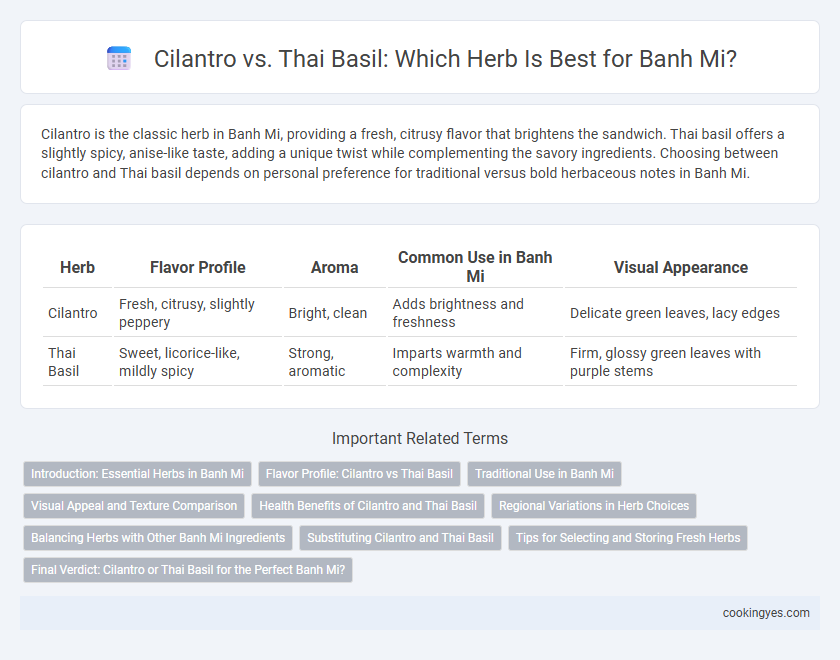Cilantro is the classic herb in Banh Mi, providing a fresh, citrusy flavor that brightens the sandwich. Thai basil offers a slightly spicy, anise-like taste, adding a unique twist while complementing the savory ingredients. Choosing between cilantro and Thai basil depends on personal preference for traditional versus bold herbaceous notes in Banh Mi.
Table of Comparison
| Herb | Flavor Profile | Aroma | Common Use in Banh Mi | Visual Appearance |
|---|---|---|---|---|
| Cilantro | Fresh, citrusy, slightly peppery | Bright, clean | Adds brightness and freshness | Delicate green leaves, lacy edges |
| Thai Basil | Sweet, licorice-like, mildly spicy | Strong, aromatic | Imparts warmth and complexity | Firm, glossy green leaves with purple stems |
Introduction: Essential Herbs in Banh Mi
Cilantro and Thai basil are essential herbs that define the authentic flavor profile of Banh Mi sandwiches. Cilantro offers a fresh, citrusy brightness that complements the savory meats and pickled vegetables, while Thai basil provides a slightly sweet, anise-like aroma adding depth to the overall taste. Choosing between cilantro and Thai basil can significantly influence the traditional Vietnamese Banh Mi experience.
Flavor Profile: Cilantro vs Thai Basil
Cilantro in banh mi delivers a fresh, citrusy, and slightly peppery flavor that brightens the sandwich's overall taste profile. Thai basil offers a more aromatic, sweet, and mildly spicy note with hints of anise and licorice, creating a deeper, complex herbaceous layer. Choosing between cilantro and Thai basil significantly impacts the banh mi's flavor, balancing freshness versus aromatic depth.
Traditional Use in Banh Mi
Traditional Banh mi recipes predominantly use cilantro as the herbal garnish, contributing a fresh, citrusy aroma that complements the pickled vegetables and savory proteins. Thai basil is less commonly used in classic Banh mi sandwiches but offers a spicier, anise-like flavor more typical in other Southeast Asian dishes. Authentic Banh mi relies on cilantro to achieve the signature herby brightness integral to its distinctive taste profile.
Visual Appeal and Texture Comparison
Cilantro offers a bright green color and delicate, feathery leaves that create a fresh, airy visual appeal in Banh mi sandwiches, while Thai basil provides darker, glossy leaves with purple stems contributing to a more vibrant and complex look. The texture of cilantro is soft and tender, enhancing the sandwich with a light, almost leafy crunch, whereas Thai basil's sturdy, slightly chewy leaves introduce a more substantial bite and a subtle anise flavor. These contrasting visual and textural qualities influence the overall sensory experience, making the herb choice critical for customizing the Banh mi's signature freshness and complexity.
Health Benefits of Cilantro and Thai Basil
Cilantro in Banh mi provides powerful antioxidants and vitamins A, C, and K, contributing to improved digestion and anti-inflammatory effects. Thai basil offers essential oils with antimicrobial properties and is rich in vitamin K, which supports blood clotting and bone health. Both herbs enhance the sandwich's flavor while delivering unique health benefits that promote overall wellness.
Regional Variations in Herb Choices
Cilantro dominates as the traditional herb in Northern Vietnamese Banh mi, offering a fresh, citrusy flavor synonymous with the region's culinary style. In contrast, Southern Vietnam's Banh mi often incorporates Thai basil, which provides a sweet, anise-like aroma that complements the richer, sweeter regional condiments. These herb choices highlight regional variations reflecting local taste preferences and ingredient availability, shaping the unique flavor profile of Banh mi across Vietnam.
Balancing Herbs with Other Banh Mi Ingredients
Cilantro provides a bold, citrusy flavor that complements the savory, pickled vegetables and rich pate in banh mi, balancing the sandwich's complex layers with its fresh brightness. Thai basil introduces a slightly sweet, anise-like aroma that enhances the heat from chili peppers and the umami of grilled meats, offering a nuanced herbal contrast. Selecting between cilantro and Thai basil depends on the desired flavor profile, ensuring harmony among the bread, protein, vegetables, and condiments for an authentic banh mi experience.
Substituting Cilantro and Thai Basil
Substituting cilantro in banh mi with Thai basil introduces a slightly sweeter and more aromatic flavor that complements the sandwich's savory ingredients. While cilantro offers a fresh, citrusy taste and slight peppery notes, Thai basil imparts a licorice-like fragrance and a subtle hint of spice. Choosing between cilantro and Thai basil depends on desired flavor profiles, with cilantro providing brightness and Thai basil delivering herbal complexity to banh mi.
Tips for Selecting and Storing Fresh Herbs
When selecting herbs for banh mi, choose fresh cilantro with vibrant green leaves free from wilting or yellowing, as this herb provides a classic, citrusy flavor essential to the sandwich's authenticity. Thai basil should have glossy, deep purple stems and fragrant, slightly spicy leaves to add a unique twist with its anise-like aroma. Store cilantro and Thai basil in the refrigerator wrapped in a damp paper towel inside a plastic bag to maintain freshness while extending shelf life up to one week.
Final Verdict: Cilantro or Thai Basil for the Perfect Banh Mi?
Cilantro remains the traditional herb for banh mi, delivering a bright, citrusy flavor that complements the sandwich's savory ingredients perfectly. Thai basil offers a unique, slightly sweet and anise-like taste, providing a fresh twist for those seeking a bolder herbaceous note. The final verdict depends on personal preference: cilantro for authentic, classic flavor or Thai basil for an innovative, aromatic variation in banh mi.
Cilantro vs Thai basil for Banh mi herbs Infographic

 cookingyes.com
cookingyes.com